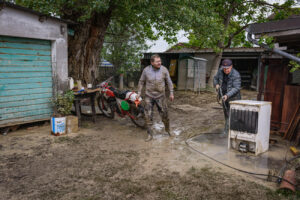Every little thing we need to let go
In 2023, between May 16 and 18, 350 million cubic meters of water, equivalent to six months’ worth of rain, fell within 36 hours across the region of Emilia-Romagna, one of Italy’s most important agricultural regions. The heavy rainfall resulted in the overflowing of 23 rivers throughout the region, affecting 100 municipalities and causing over 400 landslides. These floods were preceded by a drought that had parched the land, reducing its capacity to absorb water. This meteorological and hydrogeological event led to the loss of 15 lives and the displacement of more than 35,000 people, with estimated damages exceeding 8.8 billion euros. The region is still grappling with the consequences of this catastrophe.
Andrea and Chiara live together in their farmhouse in the countryside of Faenza, Ravenna, surrounded by a small piece of cultivated land. They were cut off from the outside world on the evening of May 16 when a violent deluge of water and mud inundated the area, reaching a height of 175 cm in a matter of minutes, forcing them to seek refuge on the first floor in their bedroom without electricity or communication. They tried to save their chickens and cats.
Beyond the immediate losses in their crops, the slow drainage of the water remaining in the soil is compromising the plant roots, risking rot and jeopardizing entire plantations that will take years to become productive again. While seasonal rains have always been a constant in the lives of these areas, there is no doubt that climate change is increasing their intensity and decreasing their frequency.
What will be the impacts of the next rainfall, and what will be its consequences?
Every little thing we need to let go
Tra il 16 e il 18 maggio 2023, 350 milioni di metri cubi di acqua, equivalenti a sei mesi di pioggia, sono caduti in 36 ore in tutta l’Emilia-Romagna, una delle regioni agricole più importanti d’Italia.
Le forti precipitazioni hanno provocato lo straripamento di 23 fiumi in tutta la regione, interessando 100 comuni e provocando più di 400 frane. Queste inondazioni sono state precedute da una siccità che aveva inaridito la terra, riducendo la sua capacità di assorbire l’acqua. Questo evento meteo-idrogeologico ha causato la morte di 15 persone e lo sfollamento di oltre 35.000 persone, con stima dei danni che ammontano oltre 8,8 miliardi di euro. La regione sta ancora subendo le conseguenze di questa catastrofe.
Andrea e Chiara vivono insieme nella loro casa colonica nelle campagne di Faenza RA, circondata da un piccolo appezzamento di terra coltivato. Sono rimasti isolati dalla sera del 16 maggio quando una violenta massa di acqua e fango ha inondato la zona, raggiungendo una altezza di 175 cm in pochi minuti e costringendoli a rifugiarsi al primo piano nella loro camera da letto senza elettricità né comunicazioni. Hanno cercato di salvare le loro galline e i gatti.
Oltre ai danni immediati subiti nei raccolti persi, il lento deflusso dell’acqua rimasta nel terreno sta compromettendo le radici delle piante, rischiando di farle marcire e mettendo a repentaglio intere piantagioni che impiegheranno anni prima di tornare a essere produttive. Le piogge sono sempre state una costante stagionale nella vita di queste aree, ma non c’è dubbio che il cambiamento climatico stia aumentando la loro intensità e riducendo la loro frequenza. Quali saranno gli impatti della prossima tempesta e quali saranno le sue conseguenze?














